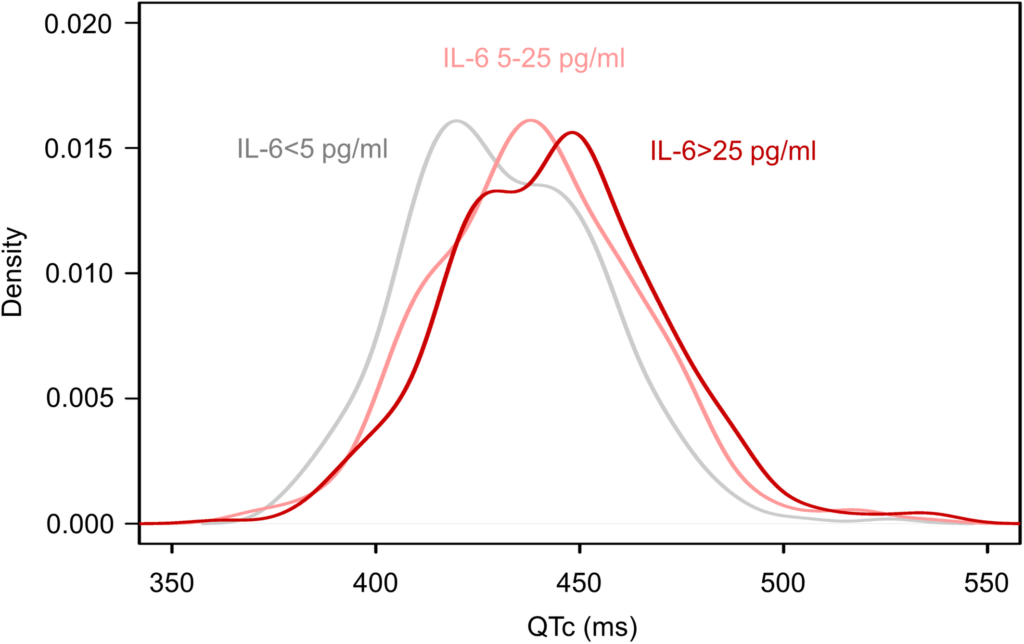
Click to Enlarge: Empirical distribution of QTc values in the overall cohort, stratified by IL‐6 level.
IL‐6 indicates interleukin‐6; and QTc, heart rate‐corrected QT interval. Source: Journal of the American Heart Association
BROOKLYN, NY— Long QT syndrome (LQTS) is a cardiac disorder that predisposes patients to malignant arrhythmias, particularly Torsades de Pointes ventricular tachycardia, which can degenerate to cardiac arrest.
Although the term LQTS is often used to identify the rare congenital form of the syndrome, acquired LQTS is actually quite common, observed in up to 30% of hospitalized patients, according to published reports. For some time, acquired LQTS has been associated with a variety of medications.1
More recently, research has pointed to the role of inflammatory and autoimmune factors, said Mohamed Boutjdir, PhD, whose new study demonstrated that one of these factors is high levels of interleukin-6. This finding, he told U.S. Medicine, could lead to new therapies for this potentially life-threatening disorder.
Boutjdir, who is associate chief of staff for research and development at the VA’s New York Harbor Health Care System, first investigated a possible role of interleukin-6 in LQTS in a 2017 study which showed IL-6 was elevated 15–20 times basal levels in 40 patients with Torsade de Pointes.1
“Other inflammatory factors, while elevated, were not so to the same degree. Therefore, we decided to investigate the arrhythmogenic role of IL-6 in a larger cohort of unselected subjects to determine its impact on the general population,” Boutjdir said. To do that, he and his colleagues utilized the VA Informatics and Computing Infrastructure (VINCI) to develop a cohort of patients who underwent both electrocardiography and IL-6 level quantification at VA facilities.
From there, the patients were sorted by the demographics, medication regimen and other comorbidities to elucidate the effect of IL-6 on the QT interval. The interval, which is determined by measuring in milliseconds (ms) the duration from the onset of the Q wave to the conclusion of the T wave, provides an approximation of the time required for the ventricles of the heart to begin contraction and then complete relaxation. When the QT interval is either unusually prolonged or shortened, it is linked with an elevated likelihood of experiencing irregular heart rhythms.
Their investigation, reported in the Journal of the American Heart Association, found that increased IL-6 levels were independently associated with QT prolongation at several cutoffs for arrhythmic risk, ranging from least stringent (>440ms) to most stringent (>500ms). 2
Boutjdir said the results from the new study agreed with those from 2017 with significantly higher statistical power due to the increased sample size (1085 vs 40). “However, I was surprised at the degree of prolongation caused by IL-6.”
IL-6, a cytokine, can act through many roles and pathways, Boutjdir explained. “Its primary role is immune in nature; however, it can act in pro-inflammatory, anti-inflammatory and even hormonelike manners, depending on the mechanism and receptor sites available on a particular cell.”
IL-6 levels may be elevated as the result of an underlying autoimmune or inflammatory disease. “For example, rheumatoid arthritis is an autoimmune and inflammatory disease that dramatically increases the levels of IL-6 in the body. This IL-6 can then have knock-on effects in the heart and cause QT prolongation,” he said.
Based on this new understanding, it is possible that IL-6 –inhibiting drugs could be a tool for treatment of QT prolongation. “Would an IL-6 inhibitor be used as a primary therapy for long QT syndrome? Potentially for IL-6 induced QT prolongation and maybe, more in general, for IL-6 associated cardiac arrhythmias, also including atrial fibrillation and atrioventricular blocks,” Boutjdir said. “This also is because accumulating data from recent clinical trials are making it more and more realistic that cytokine-targeting therapies could, in the near future, represent an essential tool to achieve a truly comprehensive treatment of cardiovascular disease, possibly including cardiac arrhythmias.”
“The causes of long QT syndrome, particularly acquired long QT, are myriad in nature,” Boutjdir continued. “Classically, drug-induced acquired long QT is always thought of first, but acquired long QT due to inflammatory and autoimmune factors is continually gaining relevance.” He stressed it’s important to realize the degree of arrhythmic risk that these lesser recognized factors can impart, and remember there can be many solutions to the problem.
- Lazzerini, P. E., Laghi-Pasini, F., Bertolozzi, I., Morozzi, G., et al. (2017). Systemic inflammation as a novel QT-prolonging risk factor in patients with torsades de pointes. Heart (British Cardiac Society), 103(22), 1821–1829. https://doi.org/10.1136/heartjnl-2016-311079
- Lazzerini, P. E., Cupelli, M., Cartocci, A., Bertolozzi, I., et al. (2024). Elevated Interleukin-6 Levels Are Associated With an Increased Risk of QTc Interval Prolongation in a Large Cohort of US Veterans. Journal of the American Heart Association, 13(4), e032071. https://doi.org/10.1161/JAHA.123.032071

